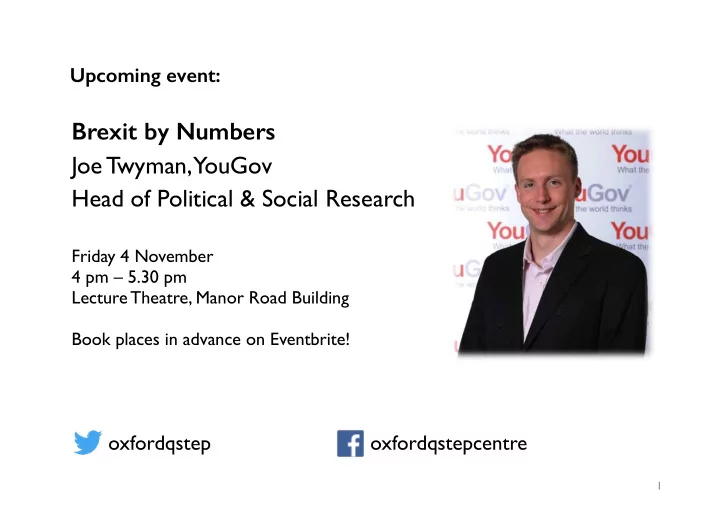

Upcoming event: Brexit by Numbers Joe Twyman, YouGov Head of Political & Social Research Friday 4 November 4 pm – 5.30 pm Lecture Theatre, Manor Road Building Book places in advance on Eventbrite! oxfordqstep oxfordqstepcentre 1
Observational studies ! Control for: determinants of X a ! that might also affect Y ! And: determinants of Y that are in any way related to X ! Noting that: the impact of X on Y might be conditional on b ! some value of Z b !
Lab 3: Analysis of Experimental Data Political Analysis 2: Week 4 2
Experiments in a nutshell ! • Many units in a study group. ! • Some are randomly assigned to control. ! • Others are randomly assigned to treatment. ! • We compare sample averages of the control group and the treatment group after the treatment has occurred. ! • But the thinking behind this is quite subtle… !
The Neyman Model Think about potential outcomes… ! Figure 5.1 (p113) from Dunning, T. (2012) !
Getting to counterfactual thinking… ! • Unit causal effect = ??? ! – A unit’s potential outcome if treated minus its potential outcome if untreated (control)..??? ! – Not all units will respond the same. ! – Holland (1986): “the fundamental problem of causal inference”. ! • Without factual and factual to compare, we settle for factual and counterfactual. !
Why difference of means? ! • Average causal affect Average causal affect = the difference between the average outcome if all units in the study were assigned to treatment and the average outcome if all units in the study were assigned to control. ! • Mean of a random sample = an unbiased estimator of the population mean. ! • Thus, the mean outcome of treatment group = an unbiased estimator for the mean of the potential outcomes under treatment. ! • An unbiased estimator for the average causal effect = difference of means. !
Validity ! • Internal? ! – Fully randomised? ! – SUTVA (the stable unit-treatment value assumption) ! • External? ! – Can we reasonably extrapolate to other contexts? !
“Prior to the August 2006 primary election in Michigan, approximately 80,000 households were sent one of four mailings encouraging them to vote.” (33) 3
Theory (GGL 2008) • Utility (happiness) citizens receive from performing their civic duty is key to predicting turnout à Intrinsic benefits. Satisfaction from behaving in • accordance with norm (voting). à Extrinsic incentives. Social pressure to comply. •
Research Design (GGL 2008) • 180,002 households in Michigan (United States) drawn as a (random?) sample of all households in the state. • 20,000 HH each in four different treatment groups (and a further 100K HH in control group) • 1. “Civic Duty” mailing • 2. “Hawthorne” mailing • 3. “Self” mailing • 4. “Neighbors” mailing
4
5
6
7
8
If you want more… ! • IR: ! – Hyde, Susan D. "Experiments in International Relations: Lab, Survey, and Field." Annual Review of Political Science 18 (2015): 403-424. ! – Hafner-Burton, Emilie M., Brad L. LeVeck, and David G. Victor. "How Activists Perceive the Utility of International Law." The Journal of Politics 78, No. 1 (2016): 167-180. ! • Comp Gov: ! – Gonzalez Ocantos .E. et al. (2012) ‘Vote Buying and Social ! Desirability Bias: Experimental Evidence from Nicaragua’, AmericanJournal of Political Science, 56(1), 202-217 Data: http://www.chadkiewietdejonge.com/research/ ! • Pol Soc: ! – Bansak et al. (2016). "How economic, humanitarian, and religious concerns shape European attitudes toward asylum seekers". Science, 354(6309), 217-222. !
Recommend
More recommend